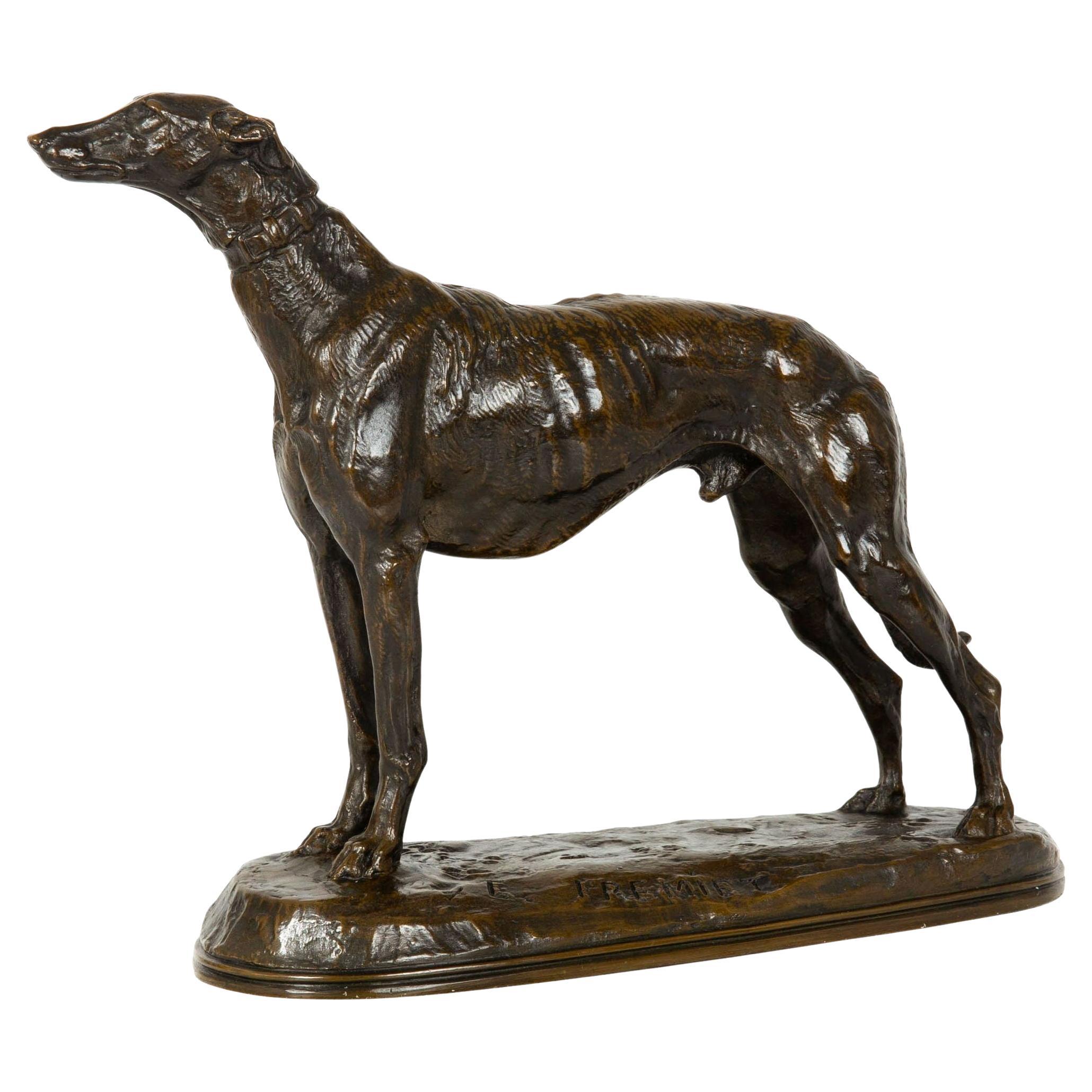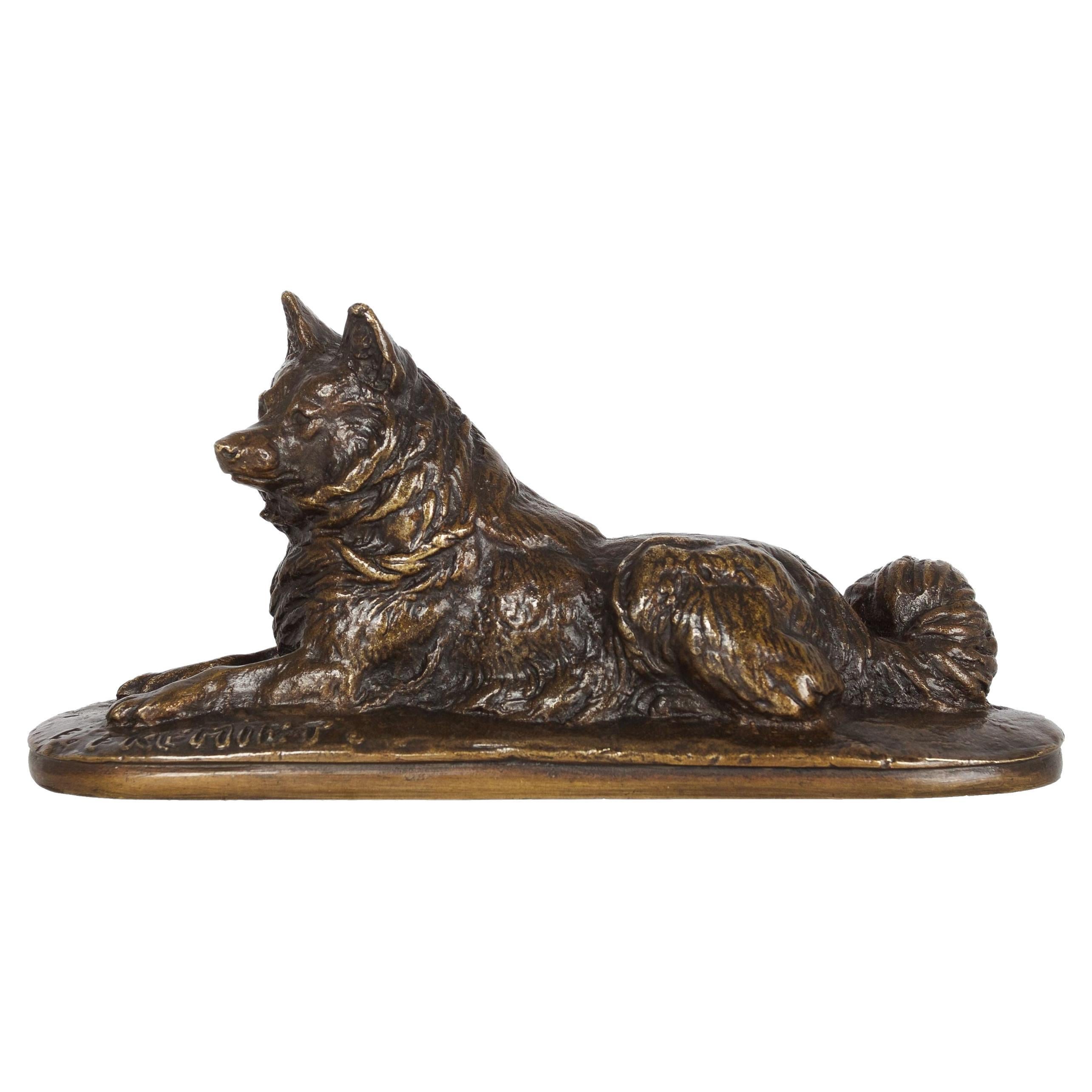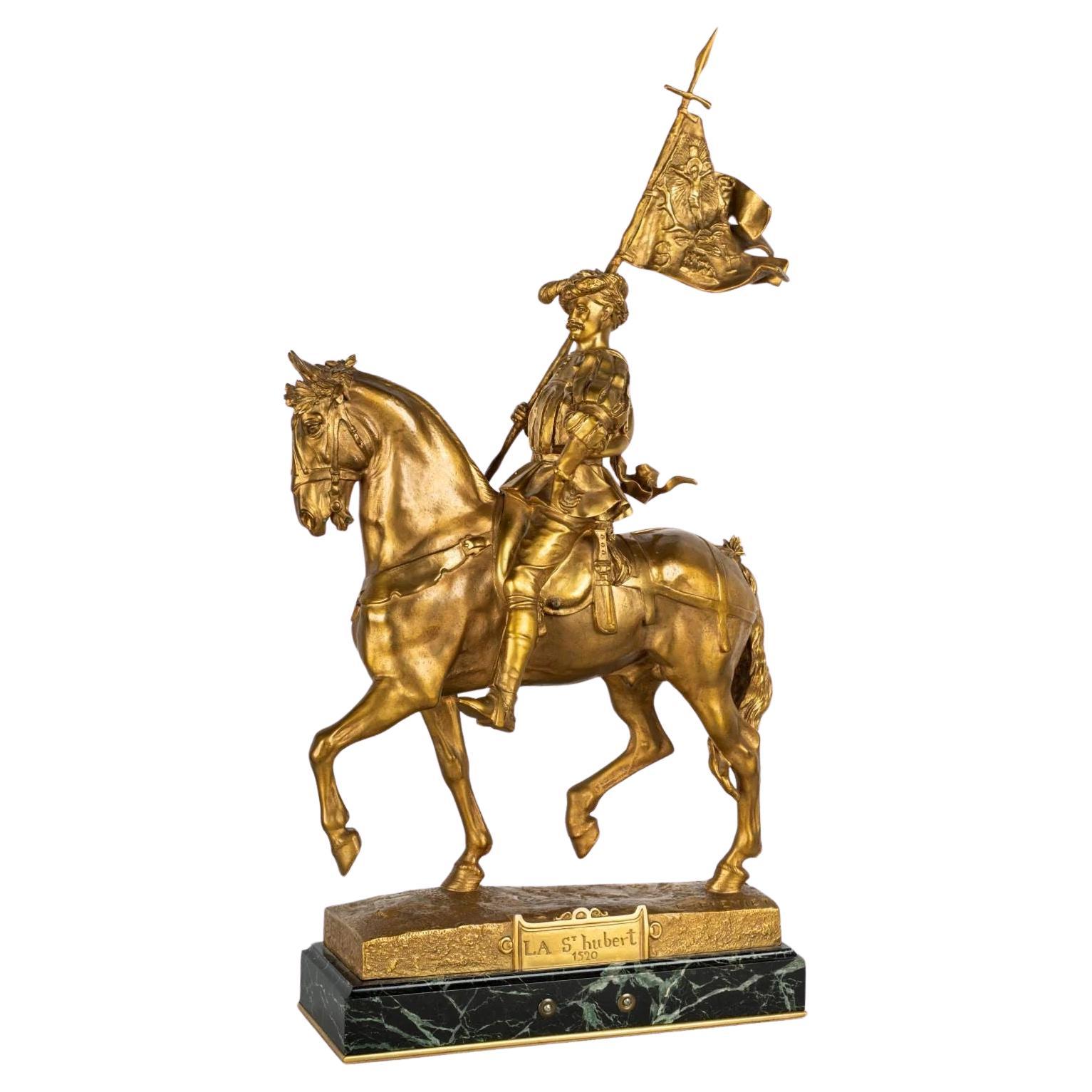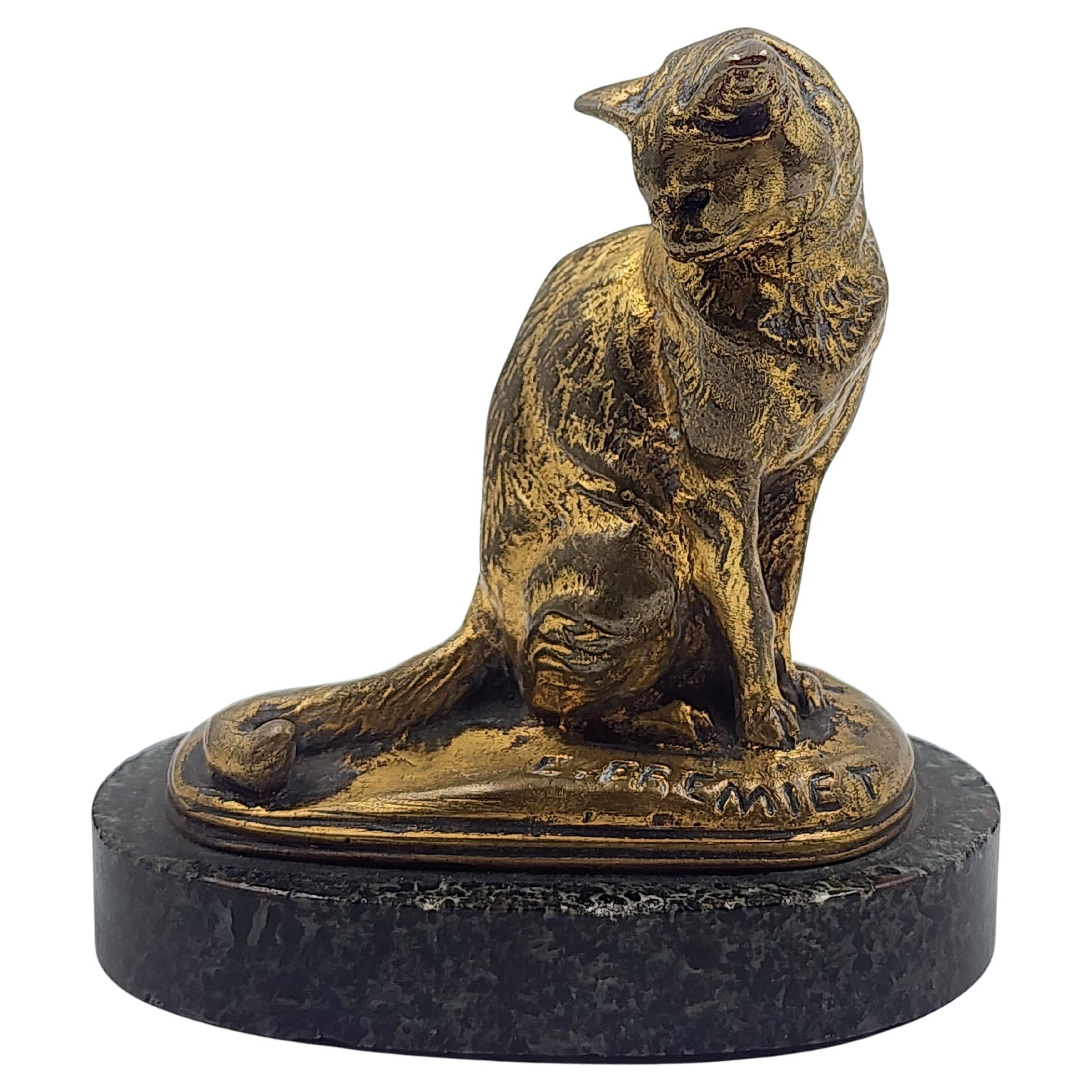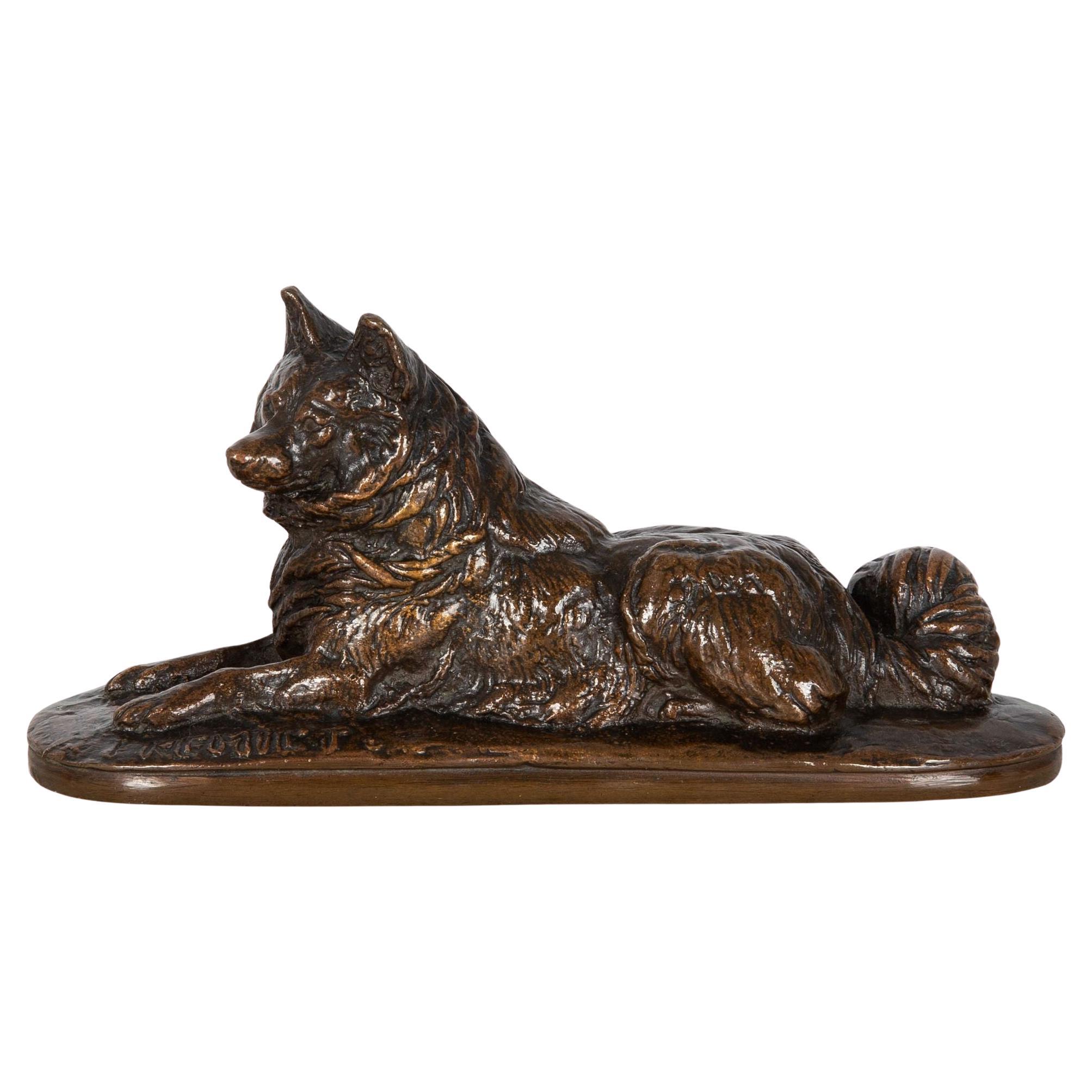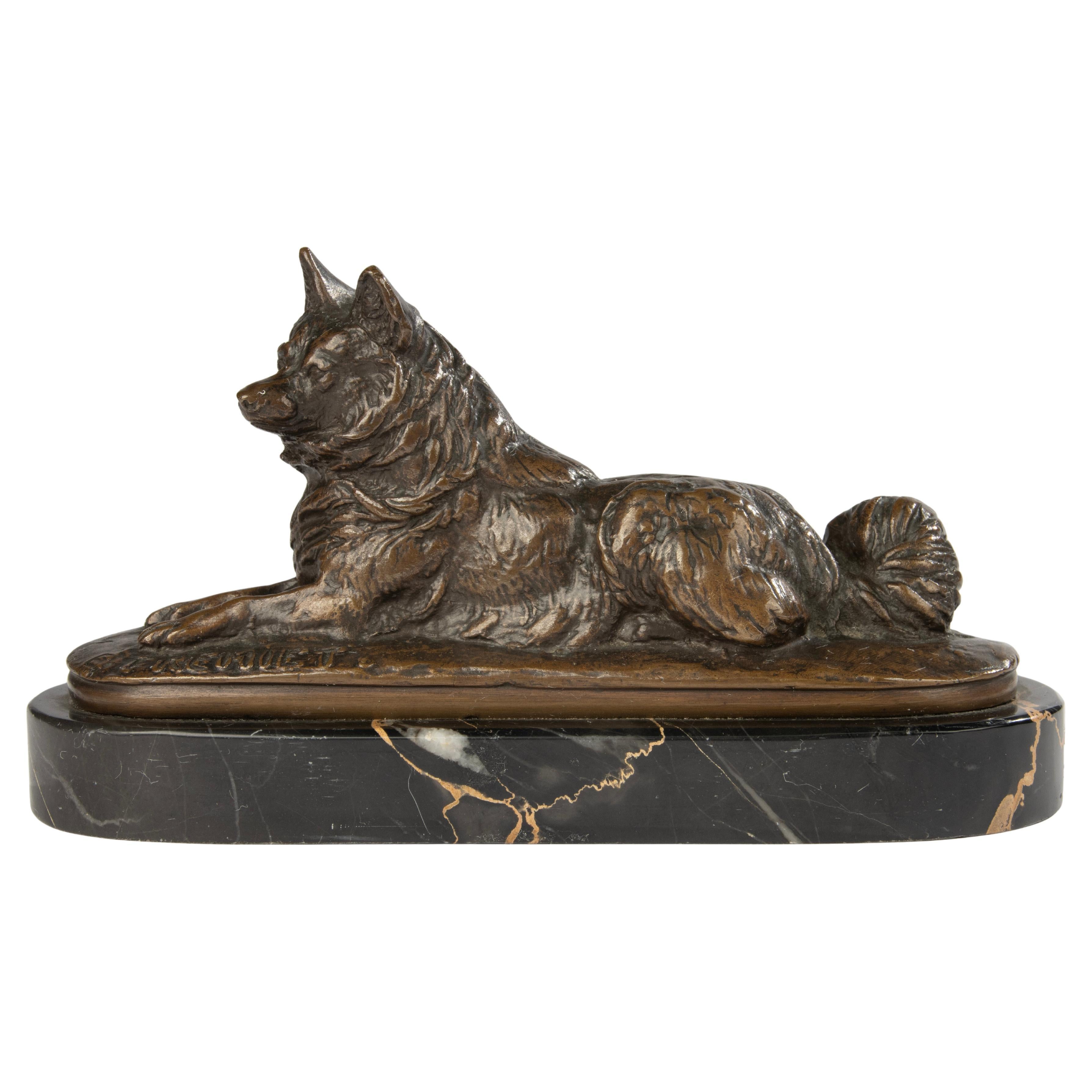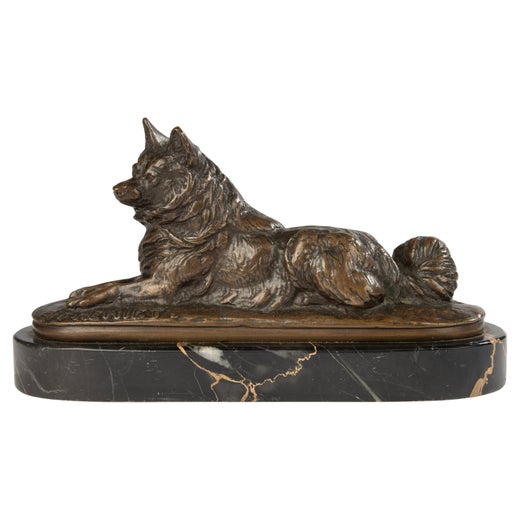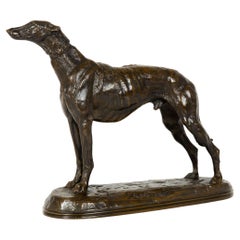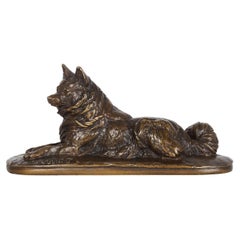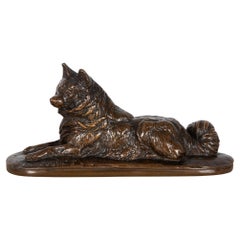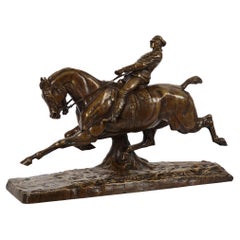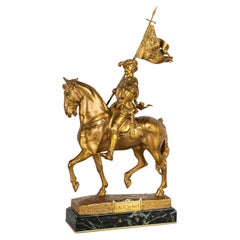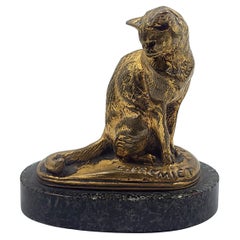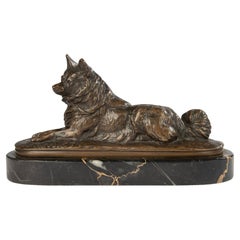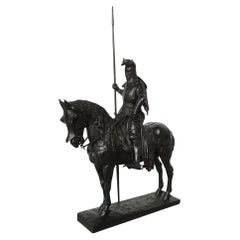Items Similar to French Sculpture “Monkey Studying a Snail” by Emmanuel Fremiet ca. 1895
Want more images or videos?
Request additional images or videos from the seller
1 of 21
French Sculpture “Monkey Studying a Snail” by Emmanuel Fremiet ca. 1895
$1,900
£1,430.53
€1,662.08
CA$2,675.22
A$2,980.39
CHF 1,563.56
MX$36,402.42
NOK 19,797.61
SEK 18,552
DKK 12,406.09
About the Item
EMMANUEL FREMIET
French, 1824-1910
"Singe à l’escargot" (Monkey Studying a Snail)
Patinated terracotta, stamped FREMIET and signed E. FREMIET in the base
Circa 1895
10 7/8" W x 6 3/4" H x 6 1/4" D
This finely modeled terracotta depicts a monkey seated on a rocky base, its head and body bent forward in concentrated study of a snail at its feet. The form is composed in a single piece, with the figure’s rounded silhouette enclosing a compact, inward-turned space that heightens the sense of absorption. The fur is rendered with tightly worked modeling, contrasted with the smoother textures of the snail’s shell and the surrounding vegetation.
The design is documented in bronze as early as the mid-1890s, with a chef-modèle recorded around 1895. It first appears in the records of the Manufacture Nationale de Sèvres in 1896, where it was produced in biscuit porcelain until 1942. Surviving examples also exist in stoneware from the Musée Baron-Martin in Gray. While its first appearance in Sèvres documentation might suggest a new commission, there is no evidence the model was created specifically for the manufactory. Frémiet is known to have supplied Sèvres with existing designs in exchange for reproduction rights, and Singe à l’escargot likely entered the catalogue in this way, having already been issued in bronze by foundries such as More and Barbedienne.
The pose and subject bear a conceptual link to Frémiet’s dramatic Orang-outang et sauvage de Bornéo, but here the intensity of physical struggle is replaced with quiet observation. It is possible that Frémiet drew upon the same studies of simian anatomy and behavior that informed the earlier work, repurposing them to create a composition of reflective stillness. The dating of the model falls within a decade (1885–1895) in which Frémiet produced a number of notable animal subjects, including Cheval pour le sang (1885), Anne du Caire (1890), Chiens lévriers (1886) and Poule aux œufs d’or (1897).
The treatment of the base, with its layered foliage and rocky forms, closely parallels Frémiet’s work in other reliefs of the period. The minute detail of the snail itself plays a structural and thematic role, aligning the sculpture with a compositional tendency in Frémiet’s work: the introduction of a small, peripheral figure or object that acts as a visual focal point. In Renard, Chatte mangeant une souris, Courlis et grenouille, and Chien griffon à la tortue, the entire visual tension of the piece converges on a diminutive creature: the frog, tortoise, or mouse. It is the small curiosity that has the larger subject’s attention entirely fixed. The snail here serves precisely this function: its near-absence of movement and scale contrast with the coiled, attentive energy of the monkey. This works to sustain both the tension and the unity of the composition.
Curator's Note:
In the latter half of the 19th century, monkeys captivated the public imagination as symbols of curiosity and latent intellect. Advances in natural history, encounters with exotic fauna and Darwinian discourse on evolution heightened interest in primates. Frémiet’s Monkey Studying a Snail exemplifies this cultural fascination, not through intense or sensational drama, but rather via a subtle observation of a possibly contemplative creature in nature.
Unlike his gorilla or orang‑utan tableaux, which evoked tension or drama, this work presents the monkey engaged in quiet study, a gesture that invites reflection on cognition and the thin line between animal instinct and thought. The choice of a snail reinforces the theme of deliberate, patient observation in miniature. This aligns with the broader shift in the period toward viewing animals not merely as resources or curiosities, but as expressive beings with their own agency. This same motif is found echoed across naturalist literature, scientific illustration, and emerging ethnographic studies of the late 19th century.
Emmanuel Fremiet:
Born Paris, 6 December 1824, Emmanuel Fremiet was the nephew and pupil of sculptor François Rude and he initially trained in anatomical lithography and model-making. In 1843 he debuted at the Salon with a study of a gazelle, followed by Wounded Bear and Wounded Dog (1850), both acquired by the Luxembourg Museum.
In the 1850s, Frémiet became notable for animal and Napoleonic subjects, including statuettes of Napoleon III’s basset hounds exhibited at the Paris Salon (1853) and commissioned statuettes for the emperor (1855–1859). He produced public equestrian monuments: Napoleon I (1868), Louis d’Orléans (1869), and the gilded bronze Jeanne d’Arc (1874) in Place des Pyramides, later replaced in 1889; this statue remains a Paris landmark.
His animalier works include Pan and the Bear Cubs (Musée d’Orsay), Elephant trapped (Musée d’Orsay), and notably the sensational Gorilla Carrying off a Woman (1887), awarded a Salon medal of honour, and Orang‑outang strangling a Borneo savage (1895) for the Natural History Museum of Paris.
Other significant public and monumental works include the Saint Michael terrassant le dragon (1897) atop Mont‑Saint‑Michel, the equestrian Velázquez in the Louvre gardens, and the Ferdinand de Lesseps monument (1899) in Port‑Saïd. Frémiet was named Officer of the Legion of Honour (1878), elected to the Académie des Beaux‑Arts (1892), and succeeded Barye as professor of animal drawing at the Natural History Museum in Paris.
He died in Paris, 10 September 1910
Condition: Exquisite original condition. No observed flaws.
Literature:
Emmanuel Fremiet 1824-1910. La main et le multiple, Catherine Chevillot, 1989, p. 86, the present model discussed as catalog no. 60
ref. 506PLT20P
About silla antiques & art
Established in 2009, we have available in our 9000 square foot brick-and-mortar gallery an ever-changing selection of carefully curated and catalogued furniture, decorative arts, paintings, sculpture and estate jewelry. Our company has long specialized in sculpture circa 1860 through 1930 and as such the gallery always has a very large collection of exceptional European and American sculpture available on display.
The gallery is located at 117 W Burd Street in Shippensburg, Pennsylvania and is open by appointment only. We welcome your visit and would love to meet with you at the shop. For clients located outside of the area, we are always available to discuss items by video conferencing or by phone.
- Creator:Emmanuel Fremiet (Sculptor)
- Dimensions:Height: 6.75 in (17.15 cm)Width: 10.88 in (27.64 cm)Depth: 6.25 in (15.88 cm)
- Style:Romantic (Of the Period)
- Materials and Techniques:
- Place of Origin:
- Period:
- Date of Manufacture:1895
- Condition:Exquisite original condition. No observed flaws.
- Seller Location:Shippensburg, PA
- Reference Number:Seller: 506PLT20P1stDibs: LU1059046289762
Emmanuel Fremiet
Emmanuel Frémiet was born in Paris, France in 1824 and was brought into an upper middle-class family that had very close ties to the world of art. His family was filled with great artists and this included his Cousin Sophie who married a famous sculptor called Francois Rude. Emmanuel’s mother was also an accomplished artist who constantly encouraged him and brought him up into the world of art. At the age of five, he was already was receiving formal training in art in a private school. The start at a young age meant he was able to be accepted at the spectacular Ecole des Arts Decoratifs School at the age of sixteen. Throughout this period he learned everything he needed to then become employed by Werner as his head lithographer within a year, whose duties were to prepare drawings of both animals and men. After a long period of convincing by Sophie and Emmanuel, Francois Rude took Emmanuel as a pupil in his studio to further his learning in modeling and sculpture work. Throughout his young life, he spent a lot of time in zoological gardens and participated in dissections of any animals which had passed away during this time. By the age of seven, he had been exposed to a wide range of different wild animals. To further Emmanuel’s path in art, he was appointed the successor of Antoine Louis Barye as Professor of Drawing after Antoine’s death in 1875. With this new position and like many other great sculptors, he spent a lot of time studying and drawing at the morgue and even went to various embalmers across Paris. This was all of his training to give him the exact measurements and to be able to reproduce the muscle and bone structure of the many men and animals that he witnessed. His first sculpture was exhibited in the Paris Salon in 1843 when he was nineteen and he continued to exhibit his magnificent sculptures for the rest of his life at the Salon. He was even awarded various medals and awards from many of his pieces. As he began with the bronze sculptures, he made many small animal bronzes with very fine detail which are nowadays highly sought after by collectors and museums alike. There were many sculptors during this time that crafted pieces in which showed a cruel nature, but Emmanuel was known for the soft and gentle pieces of work which often were amusing. At the age of twenty-five, he was to receive more commissions than any other sculptor before or during his time. It became near impossible to be able to walk the streets without seeing one of Emmanuel’s many smaller bronze sculptures. This amazing sculptor continued crafting works, but also proceeded to train new sculptors, taking on near twenty pupils each time. Unfortunately, this great sculptor passed away in 1910.
About the Seller
4.9
Recognized Seller
These prestigious sellers are industry leaders and represent the highest echelon for item quality and design.
Platinum Seller
Premium sellers with a 4.7+ rating and 24-hour response times
Established in 2009
1stDibs seller since 2014
512 sales on 1stDibs
Typical response time: 1 hour
- ShippingRetrieving quote...Shipping from: Shippensburg, PA
- Return Policy
Authenticity Guarantee
In the unlikely event there’s an issue with an item’s authenticity, contact us within 1 year for a full refund. DetailsMoney-Back Guarantee
If your item is not as described, is damaged in transit, or does not arrive, contact us within 7 days for a full refund. Details24-Hour Cancellation
You have a 24-hour grace period in which to reconsider your purchase, with no questions asked.Vetted Professional Sellers
Our world-class sellers must adhere to strict standards for service and quality, maintaining the integrity of our listings.Price-Match Guarantee
If you find that a seller listed the same item for a lower price elsewhere, we’ll match it.Trusted Global Delivery
Our best-in-class carrier network provides specialized shipping options worldwide, including custom delivery.More From This Seller
View AllFrench Antique Bronze Sculpture “Standing Greyhound” by Emmanuel Fremiet
By Emmanuel Fremiet
Located in Shippensburg, PA
EMMANUEL FREMIET
French, 1824-1910
"Chien Levrier"
Patinated bronze signed E. Fremiet in naturalistic base cold-stamped 85, a Charles More cast
Item # 411PRB18X
An exquisite mo...
Category
Antique 19th Century French Romantic Animal Sculptures
Materials
Bronze
French Antique Bronze Sculpture of Husky Dog by Emmanuel Fremiet
By Emmanuel Fremiet
Located in Shippensburg, PA
A good lifetime casting by Charles More numbered 215, it captures the entirely relaxed spirit of the recumbant husky dog with its bushy tail bouncing and eye...
Category
Antique 19th Century French Romantic Animal Sculptures
Materials
Bronze
Rare Emmanuel Fremiet “Husky Dog” Bronze Sculpture, Charles More cast no. 38
By Emmanuel Fremiet
Located in Shippensburg, PA
EMMANUEL FREMIET
French, 1824-1910
Chien loulou couché
Nuanced medium-brown patina on sand-cast bronze Signed in base "E. FREMIET" a Charles More cast numbered 38
Item # 311GTS04P ...
Category
Antique 19th Century French Romantic Animal Sculptures
Materials
Bronze
French Antique Bronze Sculpture "Horse and Groom” after Emmanuel de Santa Coloma
Located in Shippensburg, PA
A good model of a young Spanish groom bracing for an intense ride on the uncontrollable Cobesse mare. It is after the model by Emmanuel de Santa Coloma that was inspired by Alfred de...
Category
20th Century French Romantic Animal Sculptures
Materials
Bronze
French Antique Bronze Sculpture of Sheep by Rosa Bonheur ca. 1860
By Rosa Bonheur
Located in Shippensburg, PA
ROSA BONHEUR
French, 1822-1899
"Mouton Broutant" or Grazing Ewe
Dark-brown patina sand-cast bronze Signed in base "Rosa B." almost certainly cast by Peyrol (unmarked) circa 1860...
Category
Antique 19th Century French Romantic Animal Sculptures
Materials
Bronze
French Art Nouveau Bronze Sculpture “Bust of Thais” by Emmanuel Villanis
By Emmanuel Villanis
Located in Shippensburg, PA
EMMANUEL VILLANIS
French, fl. 1880-1920
"Bust of Thais"
Cast signature to shoulder "E. Villanis" cold-stamped "3264" & "CB" with foundry cachet of "Societe des Bronzes de Paris" o...
Category
20th Century French Art Nouveau Busts
Materials
Bronze
You May Also Like
French 19th Century Gilt Bronze & Marble Sculpture by Emmanuel Frémiet
By Emmanuel Fremiet
Located in Los Angeles, CA
A traditional gilt bronze sculpture by Emmanuel Frémiet standing on a marble base, portraying St. Hubert riding a horse while he shows a flag depicting Jesus crucified, symbolizing h...
Category
Antique 19th Century French Figurative Sculptures
Materials
Marble, Bronze
Bronze Cat Figurine by Emmanuel Fremiet
By Emmanuel Fremiet
Located in Autonomous City Buenos Aires, CABA
This exquisite bronze figurine from the early 1900s, by renowned French sculptor Emmanuel Frémiet, depicts a seated cat with exceptional elegance and realism. The sculpture captures ...
Category
20th Century French Art Nouveau Animal Sculptures
Materials
Bronze
19th Century Bronze Sculpture of a Spitz Dog - by Emmanuel Frémiet
By Emmanuel Fremiet
Located in Casteren, Noord-Brabant
A Bronze sculpture of a lying Spitz dag. The bronze has a warm brown patina. On a Nero Portoro Marble plinth.
Beautiful quality, very refined bronze with great attention to detail. ...
Category
Antique 1890s French Belle Époque Animal Sculptures
Materials
Marble, Bronze
Louis d'Orléans late 19th century bronze sculpture by Emmanuel Fremiet
By Emmanuel Fremiet
Located in Forest Row, East Sussex
A late 19th century bronze sculpture by Emmanuel Fremiet depicting Prince Royal Louis 1st Duke of Orléans. A later cast of the original sculpture erected in the courtyard of the Chât...
Category
Antique Late 19th Century French Figurative Sculptures
Materials
Bronze
Early 1900 Gorilla Carrying off a Woman Crafted in Wood after Emmanuel Fremiet
By Emmanuel Fremiet
Located in Lisse, NL
Great wooden sculpture after the famous bronze of Emmanuel Fremiet
This handcrafted sculpture was probably made in South Tyrol by/of Josef Anton Riffeser who founded the ANRI Compan...
Category
Early 20th Century French Black Forest Animal Sculptures
Materials
Wood
Bronze Sculpture of a Gaulish Chief, Signed FREMIET.
By Emmanuel Fremiet
Located in Saint-Ouen, FR
Bronze sculpture of a Gaulish chief, signed FREMIET.
Bronze sculpture signed FREMIET, representing a Gaulish chief, 19th century, Napoleon III period.
H: 37cm, W: 26cm, D: 8,5cm
Category
Antique 19th Century French Napoleon III Figurative Sculptures
Materials
Bronze
